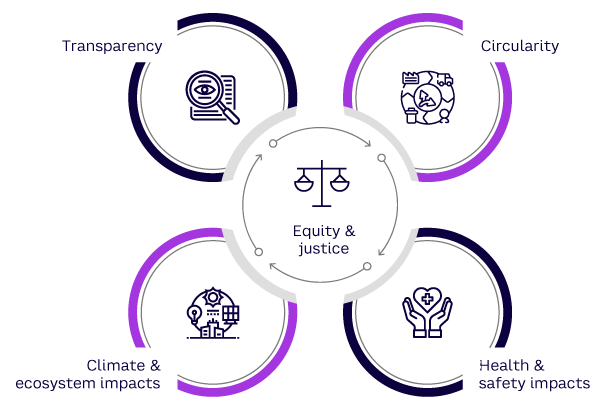Recently, an interdisciplinary group of 20 experts from industry, government, academia, and nonprofits developed a framework for a more sustainable product development process. The group’s mission was to establish a definition for the field of sustainable chemistry, but the results are directly applicable to a holistic, sustainable product development process.
The framework’s categories include equity and justice, transparency, health and safety impacts, circularity, and climate and ecosystem impacts (see Figure 1). Although it is not prescriptive, the framework provides a new modality for guiding the thought process in design by embedding considerations of safer materials and better working environments, as well as open and honest communication on product content — all with the goal of more sustainable products.
When done correctly, this method can lead to circularly designed products: those with end-of-life and product-renewal plans. Note that the business model to support the circularity is put in place up front, rather than bolted on at the end. In addition, eliminating toxins in the product-design phase reduces the chances of toxin exposure for workers and consumers throughout the value chain.

Current design paradigms often focus on profitability, particularly the twin drivers of cost minimization and market maximization. This approach results in the exclusion of sustainability considerations in the design phase. Using the proposed framework would result in an inclusive design process that embodies the essence of corporate responsibility. Products would be built only after authentically engaging with stakeholders and verifying the protection of workers and marginalized groups along the value chain. Greenhouse gas emissions would be specified alongside chemical and material safety data and included in the chain of custody. Chemicals and materials used in production would be selected for their lack of hazards and preferentially incorporated into circular products.
As companies work toward a product-design process that encompasses a commitment to corporate responsibility, they must be transparent about their goals, the steps they are taking, and where they are in the journey. If companies choose to immediately market their initial efforts as sustainable, they will open themselves up to greenwashing claims. In fact, there are recent calls to abandon the use of the term “sustainability” altogether due to misuse by companies, particularly those in the fashion industry.
[For more from the authors on this topic, see: The Future of Corporate Responsibility Begins with Product Design.]




